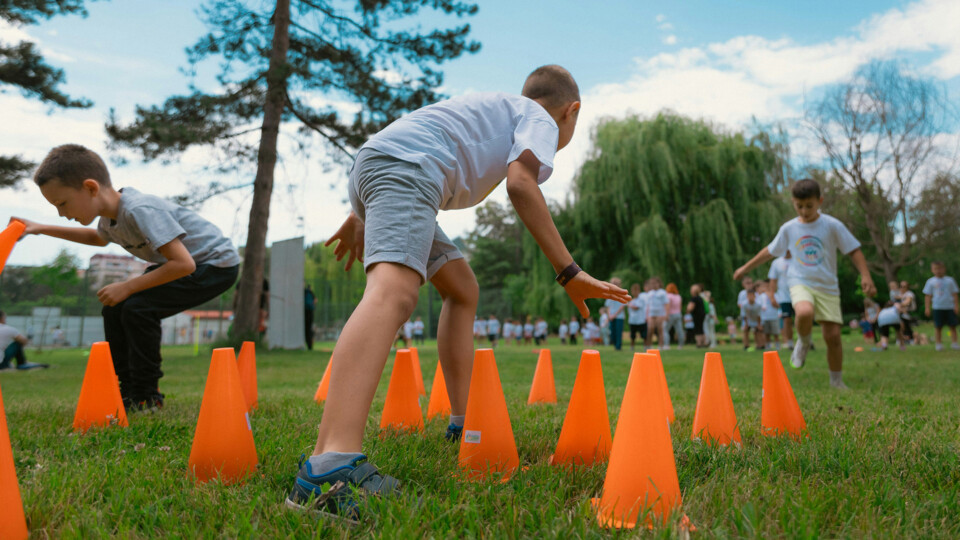Sporting chance for active schools scheme thanks to new £4m investment
An initiative to encourage Bradford children to become more active has received a huge boost thanks to a £4 million investment from Sport England.
Over the next three years, the JU:MP (Join Us Move and Play) programme will work with children and their families from across the district to help improve physical activity levels.
The University of Bradford is the research lead for the Creating Active Schools (CAS) programme, which is part of the Active Bradford partnership with plans to grow its network from 57 to 100 schools in Bradford and develop a district- wide physical activity offer.
Professor Andrew Daly-Smith, from the University of Bradford, said: “The investment by Sport England will help us build on the strong foundations of the JU:MP programme. We hope to reach even more schools, communities and families. We will work hard to improve opportunities, in partnership with Active Bradford and Born in Bradford, to improve physical activity for all and create sustainable change, especially in our most in need communities. It is a very exciting time for the University and the city.”
About JU:MP
JU:MP is funded by Sport England and led by Active Bradford, in partnership with The University of Bradford, Born in Bradford Project and Bradford Council.
The JU:MP programme has worked with multi-cultural and economically deprived Bradford communities for the last five years and has reached over 30,000 children and their families – the new funding will enable them to reach 40,000 more people.
Research into children’s activity levels conducted by researchers at Born in Bradford (part of the Bradford Institute for Health Research) and the University of Bradford, and funded by Sport England and the National Institute for Health and Care Research (NIHR) found that increased physical activity:
- Improved children’s total physical activity by 8.3 minutes a day and over 70 minutes a week – this equates to 3,640 extra minutes per child a year (or two and a half days)
- Improved moderate-to-vigorous physical activity (the amount needed to significantly improve health) by nearly 6 minutes on weekdays (5.7 minutes)
- Reduced inactivity by more than 21 minutes a day on weekends (21.47 minutes)
Executive Director, Place, Sport England, Lisa Dodd-Mayne, said: “Every child has the right to experience the enjoyment and benefits that being active brings. We need every child to have positive experiences of sport, physical activity and movement, in every aspect of their lives, if they are to find a lifelong love of being active. If we get this right, this will be the key to a happier, healthier and more resilient nation.
“Our work is built on long-term partnerships and will deliver sustainable change in the communities that need it most. Active Bradford’s efforts are nothing short of outstanding – and we’re delighted to have supported them in not only reducing inequalities and getting more children active but also raising the profile of physical activity and fostering healthier and happier communities in Bradford. This work is a pivotal moment in time showing that by working differently we can genuinely influence activity levels.”

Dr Andrew Daly-Smith, Creating Active Schools lead, from the University of Bradford.
What is CAS?
Developed in 2019, following input from headteachers, governors and education experts, Creating Active Schools is a whole-school framework to promote cultural change in adopting physical activity in all aspects of school life, which has been adopted by more than 200 schools in the UK.
CAS is a partnership between the University of Bradford and Yorkshire Sport Foundation and has already been adopted by over 250 schools nationwide.
Schools in the network have introduced changes such as closing streets to encourage walking to school, buying children weatherproof clothing to facilitate outdoor activity in all weathers and ‘active classroom’ sessions in which children move about to complete tasks.
In June 2024, the University held the first Whole-School Physical Activity (#WSPA2024) conference, with over 300 delegates from 24 countries.
Case study – Girlington Primary School
Girlington Primary School in Bradford signed up to CAS in 2020. Since then, it has introduced ‘walk and talk’ sessions in lessons, walking football, and is even teaching parents to ride bikes, all in a bid to encourage children to be more active – as part of the University of Bradford’s Creating Active Schools initiative.
Deputy headteacher of Girlington Primary School Dan Walker, said: “Children born in this part of Bradford have a life expectancy 10 years lower than those born in Wharfedale. That’s a difference of 10 years in just 10 miles. We have to do something about that.”

Deputy Head of Girlington Primary School, Dan Walker. Image Credits: University of Bradford.
So, what have they done?
Since 2020, they have changed the way they deliver lessons, making them more active, so the school’s 550 children, most of whom hail from the local area, now regularly have to get out of their seats and interact with other pupils during lessons, moving around the classroom to solve problems and find answers to questions.
They have introduced ‘walk and talk’, where pupils pair up and then walk while telling each other what they know about a subject, they have piloted ‘walking football’ in a bid to include children for whom the aggression and competitiveness associated with some traditional sports might act as a barrier. They have brought in gardening sessions and children now get to eat what they grow. Free fresh fruit is also available daily.
Even some staff meetings are now ‘stand up meetings’ in a bid to ‘practice what they preach.’
On top of that, the school has also reached out to parents, in a bid to embed the idea of physical activity in families. The main road outside school is closed to traffic for morning and afternoon drop-offs to encourage people to walk to school. There are weekly yoga classes and park walks for parents. They have even started cycling lessons for parents in a bid to embed the idea of physical activity into families.
Measuring success
The school bought 60 wristbands to count the number of steps taken by children in Years 4, 5 and 6 and data shows a marked increase in activity.
- In Autumn 2021, Year 6 children averaged 3,834 steps – that increased to 4,884 in Autumn 2023.
- Boys showed the biggest increase, from 3,722 in 2021 to 5,923 in 2023
- Girls went from 3,060 to 3,960 during the same period
- Overall, the step count is almost double what it was four years ago
“That’s how we’re making a difference,” said Dan. “It’s clear children living in different parts of Bradford have different levels of opportunity, whether that’s access to fresh fruit and veg or being able to take part in an activity. All that kind of stuff gives you aspiration and it might make you be more active, so if those opportunities are not provided at home, then we have to provide them at school.
“Our school improvement plan, like most schools, includes improving reading, writing and maths, attendance and behaviour but we also have a commitment to ensure every moment both in and out of the classroom should be used to develop children’s thinking and learning, to improve their educational and life chances. For us, that was a big change in emphasis.”
He added: “What we have found is when children are more physically active, it improves concentration and engagement.”
Pineapple proof
For Dan, the proof is in the… pineapple, as he explains.
He said: “If you drive to the top of the road, you can buy three lots of chicken and chips for £10. For many families, choices like that come down to what’s affordable, not necessarily what is the healthiest. So, we wanted to make sure while children are in school, they have healthy options.
“In our food technology classes, we have a nutrition club where children learn about cooking. They were making fruit salad recently and one child suddenly said, ‘I’ve never eaten pineapple, it’s gorgeous.’ So, that’s a small thing but it’s already expanded that child’s horizons. Imagine getting to 10 and never having eaten pineapple.”

